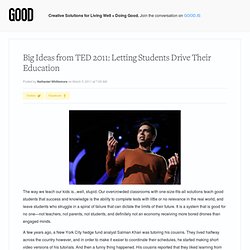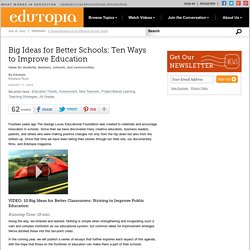

Big Ideas - Exploring the Essential Questions of Education. Big Ideas from TED 2011: Letting Students Drive Their Education - Education. The way we teach our kids is...well, stupid.

Our overcrowded classrooms with one-size-fits-all solutions teach good students that success and knowledge is the ability to complete tests with little or no relevance in the real world, and leave students who struggle in a spiral of failure that can dictate the limits of their future. It is a system that is good for no one—not teachers, not parents, not students, and definitely not an economy receiving more bored drones than engaged minds. A few years ago, a New York City hedge fund analyst Salman Khan was tutoring his cousins. Big Ideas for Better Schools: Ten Ways to Improve Education. Fourteen years ago The George Lucas Educational Foundation was created to celebrate and encourage innovation in schools.

Since then we have discovered many creative educators, business leaders, parents, and others who were making positive changes not only from the top down but also from the bottom up. Since that time we have been telling their stories through our Web site, our documentary films, and Edutopia magazine. Along the way, we listened and learned. Nothing is simple when strengthening and invigorating such a vast and complex institution as our educational system, but common ideas for improvement emerged. We've distilled those into this ten-point credo. Big Ideas. The first and most essential adaptation is determining what information is most critical for students to learn and adjusting the instructional emphasis of the program.

These instructional priorities are big ideas. For students in general and students with disabilities in particular, the sheer amount of information in the general education curriculum imposes extraordinary demands on learning. The growing amount of information to be learned is a heavy pressure on educators. As Longstreet and Shane (1993) reported in their book Curriculum for a New Millennium, it is estimated that by the late 1990s the quantity of available information will double every 24 months. In effect, this means that learners in today's schools will be exposed to more information in a year than their grandparents were in a lifetime.